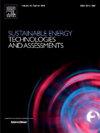Integrating solid oxide electrolysis cells and H2-O2 combustion for low-emission high-temperature heating with heat pump in the chemical industry
IF 7.1
2区 工程技术
Q1 ENERGY & FUELS
Sustainable Energy Technologies and Assessments
Pub Date : 2024-10-02
DOI:10.1016/j.seta.2024.104010
引用次数: 0
Abstract
Low-emission high-temperature heating could be achieved by exploiting electrical heating, clean fuel, or carbon capture. However, it is difficult to replace current coal or natural gas furnaces in some places because the high-temperature thermal demand needs combustion. In the present work, the green hydrogen production process by solid oxide electrolysis cells (SOEC) and H2-O2 combustion is integrated into ethylene production. The working conditions of electrolyzer and furnace are analyzed. The SOEC should work over 800°C to keep endothermic state no matter the current density. To produce the hydrogen of 80 MW heat value, the electric consumption is at least 69.4 MW. With the high-temperature waste heat of 7.76 MW, an additional 3 MW power is required for water electrolysis. The heat released during condensation of combustion products is 30.52 MW, much higher than 13.19 MW from SOEC products. Therefore, the heat pump is necessary to recycle the waste heat of water condensation and generate steam as the electrolysis ingredient and cooling medium, which saves 63 % of energy. Although the total energy consumption increases by 11.23 % from 80.23 MW to 89.24 MW, the CO2 emission drops by 84.28 %.
将固体氧化物电解槽与 H2-O2 燃烧相结合,在化工行业利用热泵进行低排放高温加热
可以通过利用电加热、清洁燃料或碳捕获来实现低排放高温加热。然而,由于高温热需求需要燃烧,在一些地方很难取代目前的煤炉或天然气炉。本研究将固体氧化物电解槽(SOEC)和 H2-O2 燃烧的绿色制氢工艺与乙烯生产相结合。分析了电解槽和电炉的工作条件。无论电流密度如何,固体氧化物电解槽都应在 800°C 以上工作,以保持内热状态。要生产 80 兆瓦热值的氢气,电力消耗至少为 69.4 兆瓦。加上 7.76 兆瓦的高温废热,水电解还需要额外的 3 兆瓦电力。燃烧产物冷凝时释放的热量为 30.52 兆瓦,远高于 SOEC 产物释放的 13.19 兆瓦。因此,有必要使用热泵来回收水冷凝的废热,并产生蒸汽作为电解成分和冷却介质,这样可以节省 63% 的能源。虽然总能耗从 80.23 兆瓦增加到 89.24 兆瓦,增加了 11.23%,但二氧化碳排放量却减少了 84.28%。
本文章由计算机程序翻译,如有差异,请以英文原文为准。
求助全文
约1分钟内获得全文
求助全文
来源期刊

Sustainable Energy Technologies and Assessments
Energy-Renewable Energy, Sustainability and the Environment
CiteScore
12.70
自引率
12.50%
发文量
1091
期刊介绍:
Encouraging a transition to a sustainable energy future is imperative for our world. Technologies that enable this shift in various sectors like transportation, heating, and power systems are of utmost importance. Sustainable Energy Technologies and Assessments welcomes papers focusing on a range of aspects and levels of technological advancements in energy generation and utilization. The aim is to reduce the negative environmental impact associated with energy production and consumption, spanning from laboratory experiments to real-world applications in the commercial sector.
 求助内容:
求助内容: 应助结果提醒方式:
应助结果提醒方式:


